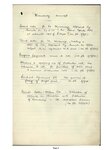MiTasol
1st Lieutenant
"In early 1941, L4448 was converted as a trials aircraft and the combination was considered a success.. The first Australian-assembled Beaufort A9-1 flew on 5 May 1941 with the first Australian-built aircraft A9-7 coming off the production line in August. .
The Beaufort parts book lists A9-1 to A9-52 as having Lockheed Hudson engine mounts, exhausts, dishpans, cowls, gills, carb scoops, etc, etc.



















